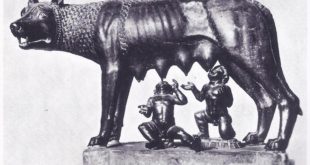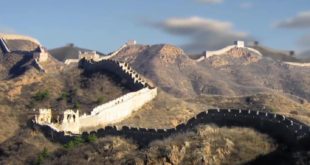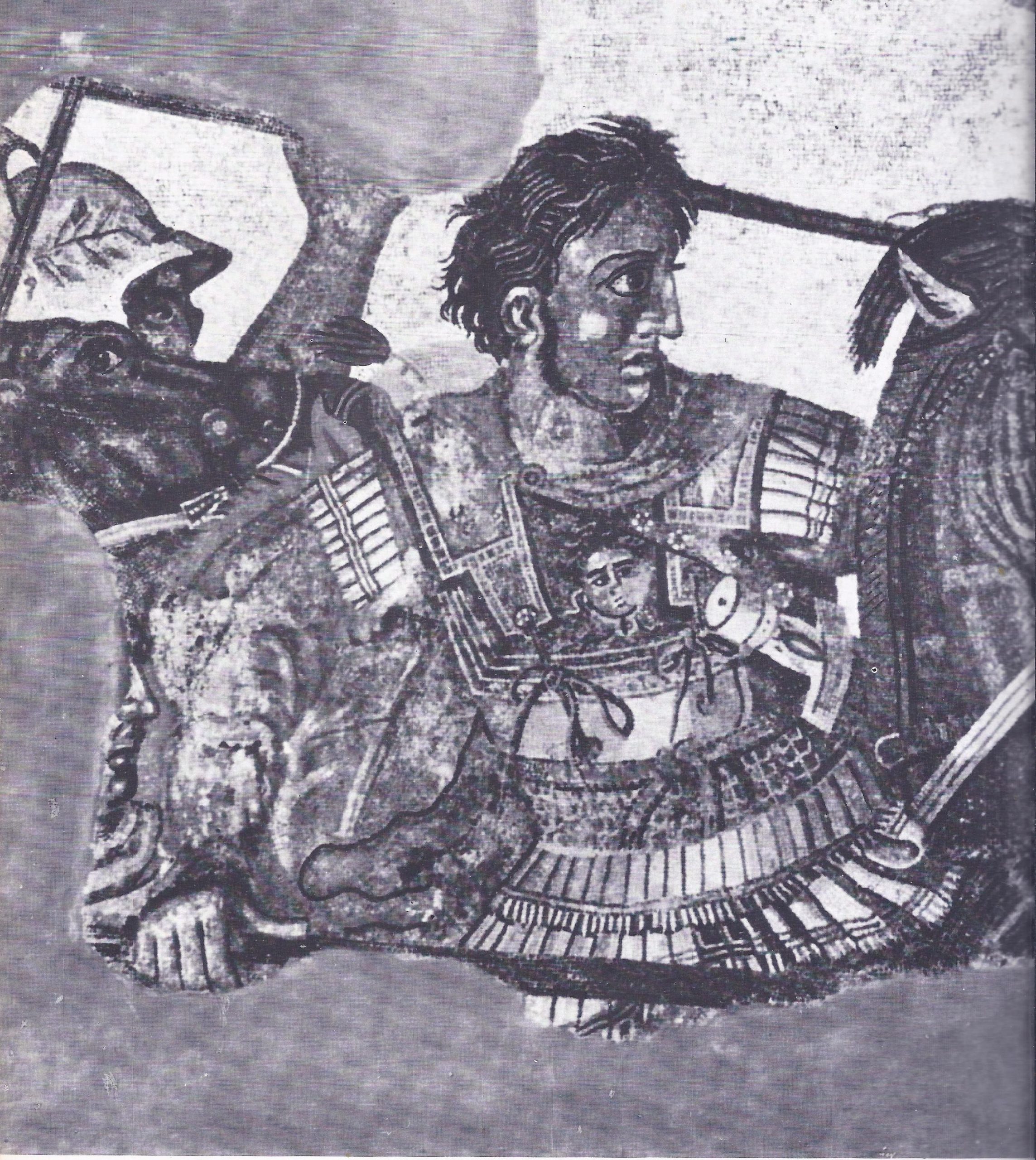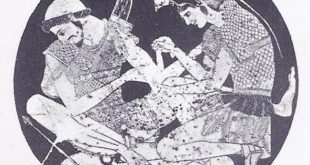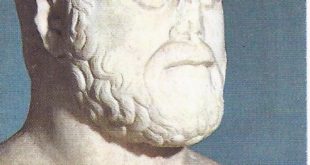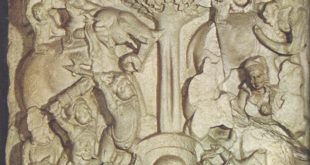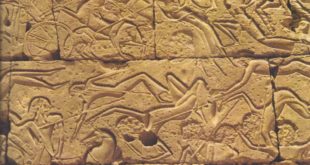The Great Wall of China did not always keep the invader out, but it did help to establish the geographical identity of the Chinese empire. The exact delineation of the boundaries of the empire gave its administration a positive geographical basis. Rome, similarly, can be traced by the vicissitudes of her rise – from small city-state to mistress of the Mediterranean world and Europe. The ultimate extension of Rome’s power gave her a vast empire and as with the empire of Shih-huangti, her territory was given a positive limit by permanent frontiers. The Great Wall of China has a smaller but still monumentally impressive parallel in Hadrian’s Wall, built in the first years of the second century A.D. across the northern part of England, to keep out unconquered tribes from the north. The whole of the Roman Empire was ringed with systems of fortifications when natural barriers were not present, as the great forts of Germany and the limes (frontier system) of North Africa indicate. Here described is a remarkable episode. It is the story of an enemy of Rome who invaded Italy and conquered what one would have supposed was an insuperable natural barrier, the Alps. According to tradition, Romulus and his brother were reared by a wolf. Hannibal The enemy was the Carthaginian leader Hannibal. His epic journey across from North Africa up through Spain, across southern France, over the Alps and into Italy is in the tradition of Alexander’s vast journeys across deserts and mountains to conquer half the world. Hannibal himself was a true product of the Hellenistic age that Alexander’s conquests had ushered in. It was an age of the professional war-leader. The outcome of military struggles largely determined the political development of the Mediterranean world at this time and the leader of a powerful …
Read More »Great Wall of China (221 B.C.)
The Great Wall of China is probably the world’s most stupendous monument to human ingenuity, human industry and purportedly is the only one of man’s works that could be seen from the moon. Finding his country a patchwork of desperate states, Shih-huang-ti, the first Emperor of China, imposed upon it unity and coherence. Centralized administration demanded swift communications, so a vast network of roads and canals was thrown across the country. Weights and measures were standardized and the same writing script introduced throughout the land. Unity, however, was of little use without security and to protect his new empire from the repeated invasions of Turco (Mongolian hordes), Shih-huang-ti built an immense wall that survives to this day. Across hill and valley, mile after mile, the mighty bastion is a vivid testimony to the will power of an absolute monarch and the imagination of a creative genius. The Great Wall extends across some 1,400 miles of northern China. The section illustrated remains as it was when rebuilt by the Ming emperors (A.D. 1368-1644). The Wall had some 25,000 watchtowers and models of it were a popular subject of Chinese art. The Wan-li ch’ang ch’eng or Wall of Ten Thousand Li (a li is approximately one-third of a mile) forms the country’s northern boundary, extending some 1,400 miles from the Gulf of Chihli in the east to the sources of the Wei River in the far west of Kansu province. Even today, centuries after its construction, the Wall remains an awe-inspiring sight. It climbs the sides of ravines and crests, the watersheds of mountain ranges, doubling back on itself so frequently that its actual length is more than double 1,400 miles. In some stretches, particularly in the desolate desert regions of the far west, the Wall has been reduced to mere mounds …
Read More »Chinese – New Empire after Alexander (B. C. 323 – 221)
The Chinese grew a new empire in the east, after the death of Alexander the Great. The empire of Cyrus and Xerxes was vast. The empire left by Alexander on his death was even larger and it did not outlast its founder. The most obvious reasons for its immediate breakup were the lack of overall homogeneity, the variety of individual characteristics and political traditions in the area it covered and the Virtual impossibility of establishing a strong central authority to hold it together. The theme of empire is a recurrent one throughout this volume: Xerxes, Alexander, Hannibal, Shih-huang-ti and lastly Augustus — all these men commanded empires. If we seek a key to the relative endurance of such empires, we should look for a durable and comprehensive administration. The great emperor Shih-huang-ti thoroughly organized the administration of his empire and even though his dynasty was overthrown, the essential framework of the Chinese state remained. We see that after the milestone of the battle of Actium, Augustus was to devote the greater part of his energy and ability to developing and improving an administration that would provide a lasting basis for the Roman Empire. Alexander’s successors were more concerned with dividing the Near East among themselves than with pushing the territorial limits of their empire, as Alexander had done, farther toward the mysterious East, as yet largely unknown to them. Contacts did undoubtedly exist between the ancient Near East and China. Some scholars have sought to trace Mesopotamian influences in early Chinese culture, but they were extremely tenuous. However, a great civilization had been developing there from the second millennium B.C., and with a significant epoch in it. In preparation for understnading it, we must consider some of the fundamental aspects of Chinese civilization. Skull of Peking Man Prehistoric Chinese China …
Read More »Alexander the Great Dies (323 B.C.)
Alexander the Great succeeded to the throne upon the assassination of Philip of Macedonia, in northern Greece. This succession, both as king and as leader to the League of Corinth, was his twenty-year-old son Alexander. In addition to the throne, young Alexander inherited his father’s mission to take revenge on the Persians on their own ground. The fulfilling of that mission and its consequences constitute one of the most glittering pages in the history of the ancient world. Alexander may not have wanted to fuse the traditions of East and West in the empire he created, but he gave Hellenism to posterity, thus bequeathing a truly international culture for the civilized world. Twelve years had passed since Alexander, the young king of Macedonia and captain-general of the League of Corinth, had stood at the helm of his ship, guiding it over the Hellespont to the shores of Asia — twelve years and twenty thousand miles of Asian roads. Now, in 323 B.C., in a world that he himself had shaken and transformed, he lay dying in his Babylonian palace, and at the doors the soldiers clamoured to see their leader. The rumour had spread that Alexander was dead already and that his death had been concealed by the guards. At last the doors were thrown open to the rough horsemen and pikemen of Macedonia; with bewilderment on their faces, they crowded silently past the king’s bed. Alexander was in his last fever, beyond speech and almost beyond life, but he made the effort to raise his yellowed face and nod some kind of greeting. That night his generals — Seleucus and Peucestas, Peithon and Cleomenes — went to the temple of Serapis and asked if they should bring their leader to the god, but the oracle answered that it would …
Read More »Classical Greece – A Golden Age and New Dynasty Dawn (480 – 323 BC)
Classical Greece was a period during which the finest products of Greek civilization were achieved, has been defined as beginning after the victory over the Persians. Its end is marked by the appearance of Macedonian soldiers in Greece and the capitulation of the Greek cities to their semi-Greek conquerors from the north. This was the first stage in the vast program of military expansion under the Macedonian king, Alexander, which ended with his death. Macedonian expansion changed the whole face of the East: in the West events were less momentous, though in the same year as the battle of Salamis the Greeks of Syracuse held back a major attack on Sicily by the Carthaginians. Achilles and Patroclus The sea Victory at Salamis had been engineered by the brilliant Athenian commander, Themistocles. The land victory at Plataea, which so decisively put an end to the Persian campaign in Greece, was the work of the Peloponnesians, especially of the Spartan commander, Pausanias and his men. Pausanias was then given the task of liberating the Ionian coastal cities from Persia, but they seem to have feared his potential as a new tyrant, as did the Spartan ephors or elders and he was relieved of his mission. Athens then took up the coastal war for which she was obviously so much better suited than Sparta, organizing the islands and cities into a confederacy under Athenian leadership, the Delian League. This league was put on a formal basis, with the allies contributing ships and money for defense, but dominated as it was by Athens, it was only a question of time before it became a de acto Athenian empire. The Ionian kinship shared by its members might have been expected to form some basis for a closer tie, but the tradition and outlook of the …
Read More »Victorious Athens (480 B.C.)
A victorious Athens was thanks to Themistocles, whose farsighted proposal that the Athenians should fight the Persians at sea rather than land, paved the way for the defeat of King Xerxes. Greece was threatened by the advance of the Persians, but even in the face of such a threat, the Greeks were unable to unite as a nation. The basis of Greek life was the “polis” or city-state and the concept of nationhood was completely foreign to this system. Eventually, however, a Hellenic league of Greek cities was formed, led by Athens and Sparta. In 480 the Persians were defeated at sea at Salamis and in 479 on land at Plataea. Had the Persians been the victors it is hard to tell how our civilization would have developed. Possibly democracy, as we know it, would never have survived. Paradoxically it was precisely because of Greece’s weakness — the independence of the city-state — that democracy, particularly in Athens, reached its highest peak of development. Thanks to Salamis it was handed on to future generations, enshrined in the legacy of Greece. The Assembly on the Pnyx, Athens’ “parliament hill,” was packed; this would be a crucial debate. The mighty Xerxes of Persia, with the greatest invasion force that Greece had ever seen, had crossed the Dardenelles and was now advancing inexorably across Thrace towards Macedonia. His engineers had even cut a canal through the peninsula of Mt. Athos for the safe passage of the force’s navy. The ruling dynasty of Thessaly had decided to collaborate with the invader and the Macedonians had given him earth and water in token of submission. The district of Boeotia was rife with Persian sympathizers. The Spartans were ready to make a stand against Xerxes; the crucial question was, where would they make it? Their traditional …
Read More »The Collapse of Crete (524 – 480 B.C.)
With the collapse of Crete, the Mediterranean focus moves to Greece. The destruction of Knossos in 1450 B.C. precipitated the end of a brilliant period in Cretan civilization. The focus of power, subsequently lay on the Greek mainland, in the great fortress-cities of Mycenae and Tiryns. These cities were remembered in Homeric legend, in the poems of the Iliad and the Odyssey. Confirmation as fact of what scholars had credited merely as legend was provided by the excavation of the site of Homer’s “Mycenae rich in gold” by the German merchant-turned-archaeologist, Heinrich Schliemann, in 1876. His discoveries there brought to light the “Mycenaean” civilization, which we now know to have been widespread in Greece from c. 1400 – 1200 B.C. It was the product of Indo-European settlers and these Mycenaean Greeks took control after the collapse of Crete, from where much of their culture originated, as the presence of Linear B tablets on both Crete and the mainland indicates. The Phaistos Disk The society which Homeric legend describes is not a society at its peak, as many scholars have noted, and the epics of “Homer” (whoever or whatever Homer might represent) foreshadow the downfall of the Mycenaean civilization. The decline of the Achaean Greeks was speeded-up by an abrupt end to their political supremacy, when the Dorian tribes swept southwards in about 1100 B.C. This may well have been part of a larger pattern of migrations that affected the western Mediterranean at about this time. The empire of the Hittites was overthrown and Egypt was attacked by the “Peoples of the Sea.” The Dorian invasion precipitated emigration of earlier Greek inhabitants from the mainland — Ionians from Attica fled to the coastal lands of Asia Minor, as did Aeolians from Thessaly; Achaeans moved into Arcadia and Cyprus. The Trojan Horse …
Read More »Buddha, the Prophet of the East (524 B.C.)
The Buddha as he came to be known, was a young man, Gautama, who followed the usual pursuits of someone of his class. He hunted, played games, feasted and had many friends. He also inspired great personal devotion, which was to stand him in good stead later. Growing discontented with his life and determined to find enlightenment, he renounced his wealth and left Kapilavastu in order to lead an ascetic life, but Gautama found that this kind of existence, practiced in isolation, did not satisfy him. He believed that compassion for his fellow men should find practical expression. He returned to Gaya where he became the ‘fully-awakened”, or Buddha and he began to teach. Although Buddhism — the faith he founded — had not become supreme in India, it won many followers in Ceylon, Burma, Thailand, Tibet and played a crucial role in the development of China and Japan. Shakravartin — “he who turns the wheel” — the ruler of the world, is shown in this marble relief of the school of Amaravati, dating from the first century B.C. or A.D. In the forested foothills of the Himalayas, in the region that is now central Nepal, there was born around the year 563 B.C. a man whose life and teachings were to have a profound influence throughout Asia and beyond. His personal name was Siddhartha, but he was known also as Gautama, the name of the family group to which he belonged. The Gautama family were Sakyas, one of a number of clans who inhabited the area between the river Ganges and the Himalayas, roughly to the northeast and northwest of the modern city of Patna. The young Gautama, who was later also to be called Sakyamuni, or “Sage of the Sakyas,” grew up in the hill town of Kapilavastu. …
Read More »Assyria, Steppelands of Central Asia Sees New People Emerge and New Empires Rise (1191 – 524 B.C.)
The vacuum left in Western Asia by the passage of the Sea Peoples was soon filled. New peoples infiltrated into the devastated areas and settled there. Some cities like Alalakh and Ugarit were never rebuilt; others rose again from their ashes. Tribes of Phrygians from Europe and their kin, the Mushki or Moschoi, divided the Anatolian plateau between them, but remnants of the Hittite peoples still continued to survive under their rule. Others, remaining outside the Phrygian orbit, retained their old traditions in the cities of southeastern Anatolia, the Taurus mountains and the plains of North Syria. Here they built temples to the old gods of the Hittite empire and the inscriptions in their palaces are written in hieroglyphic script, the ancient writing that had coexisted with cuneiform since its beginning in Anatolia. In many of these “Neo-Hittite” states, however, the ruling element was soon Semitic, for camel-riding tribesmen from the North Arabian desert moved into settled areas and took control of cities, setting up a series of political states. Once established, they flourished on commerce, acting as middlemen between the Mediterranean coast and the cities of Babylonia and Assyria. Competition, however, was to be their downfall: they proved incapable of combining. Their historical inscriptions celebrate victories over rivals, whereas a much greater danger threatened them from across the Euphrates. Capture of Lachish Assyria Expands The Assyrians, now welded into a mighty military machine of formidable efficiency, were bent on expansion. One after another, as the Assyrian armies swept westwards, the Aramaean states crumpled and were swallowed up; one after another the cities of North Syria, Carchemish and Arpad, Hamath and Damascus fell and Israel and Judah paid tribute. The wealthy coastal cities of Phoenicia bought their freedom for a time, but they too were occupied and by the seventh …
Read More »Ramses III Defeats the Sea People (1191 B.C.)
For several years the Sea Peoples from the north had been drawing closer and closer to Egypt. Syria and Libya fell to them and under the leadership of Mernera of Libya they began to prepare for an assault on Egypt itself. Merneptah, son of Ramses II, decided to take the initiative and attack first. His strategy was justfied by his resounding victory, but the Sea Peoples learned a lesson and devised a new tactic. They began to infiltrate the country in families and groups. Unknown to the Egyptian administration, a new onslaught of Sea Peoples was about to occur. Happily for Egypt there was a man equal to the situation in the person of Ramses III. In the eighth year of his reign, in 1191 B.C., Ramses III mobilized the Egyptian armies, together with their mercenaries, auxiliaries and allies, to halt an invasion of the Sea Peoples. Egypt was facing some of the toughest enemies in its history. Who were these mysterious Sea Peoples, as they are referred to in the official documents that chronicled the numerous campaigns fought against them during the reigns of Ramses II and Merneptah? Captive Sea Peoples held by the hair; from the Cairo museum. The Sea Peoples were nations of very diverse origins, engaged in joint expeditions of conquest and plunder. They included the Aqaivasha, who were probably Achaeans; the Tursha or Tyrrhenians; the Shakalsha or Zekel, who came from Sicily; the Shirdana or Sherden, who originated in Sardis or possibly Sardinia; the Denyen or Danaeans, originating from Greece; the Peleset, referred to in the Bible as Philistines; and the Louka or Lycians. These men, although from different stock, had one thing in common: Indo-European racial characteristics, with features astonishing to the Egyptians. They were “all northern peoples,” declare the Victory inscriptions of Merneptah …
Read More »